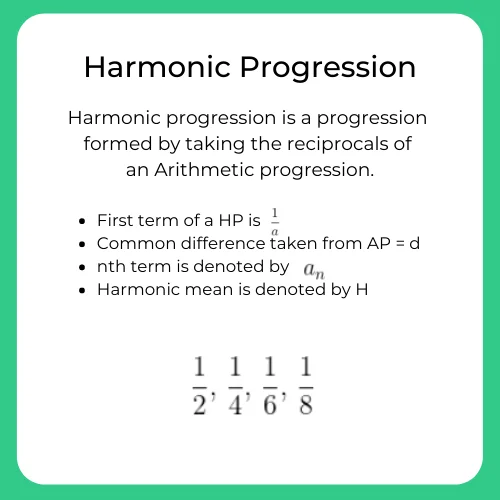0
Notifications Mark All Read
- Login
- Get Prime
Quants Menu
- HCF and LCM
- Number System
- Number Decimals & Fractions
- Surds and Indices
- Divisibility
- Ages
- LCM
- HCF
- Inverse
- Speed Time and Distance
- Work and Time
- Boats and Streams
- Pipes and Cisterns
- Averages
- Allegations and Mixtures
- Ratio and Proportions
- Simple & Compound Interest
- Simple Interest
- Compound Interest
- Percentages
- Profit & Loss
- Successive Discount 1
- Successive Discount 2
- AP GP HP
- Arithmetic Progressions
- Geometric Progressions
- Harmonic Progressions
- Probability
- Permutation & Combination
- Combination
- Circular Permutation
- Geometry
- Heights and Distances
- Perimeter Area and Volume
- Coordinate Geometry
- Venn Diagrams
- Set Theory
- Algebra
- Linear Equations
- Quadratic Equations
- Logarithms
- Clocks
- Calendars
- Clocks and Calendars
- Finding remainder of large powers
Harmonic Progressions Questions and Answers
Harmonic Progression Questions and Answers in Aptitude
Harmonic Progression Questions and Answers are provided on this page for students to practice and get an idea how this topic is asked in the exam.
Definition of HP
A Harmonic progression is a kind of sequence of real numbers made after procuring the reciprocal of the arithmetic progression.

General form of Harmonic Progression:
It is also a classification of real numbers in a way that any term in the order is the harmonic mean of its two fellow numbers.
Furthermore, if the converse of a sequence follows the rule of an arithmetic progression, then it is known as the harmonic progression.
It basically means that if a, a+d, a+2d, and so on is an A.P. then \frac{1}{a}, \frac{1}{(a+d)}, \frac{1}{(a+2d)}, and so on is known as H.P.

Key Points:
- The terms of a harmonic progression are always positive and non-zero. This is because the reciprocals of the terms must be defined, and division by zero is undefined.
- Unlike arithmetic and geometric progressions, harmonic progressions do not have a finite sum. The sum of the terms of a harmonic progression diverges, meaning it approaches infinity as you add more terms.
Prime Course Trailer
Related Banners
Get PrepInsta Prime & get Access to all 200+ courses offered by PrepInsta in One Subscription
Also Check Out

×
Please login to report
Get over 200+ course One Subscription
Courses like AI/ML, Cloud Computing, Ethical Hacking, C, C++, Java, Python, DSA (All Languages), Competitive Coding (All Languages), TCS, Infosys, Wipro, Amazon, DBMS, SQL and others
- AP GP HP – Questions | Formulas | How to Solve Quickly | Tricks & Shortcuts
- Arithmetic Progressions – Questions | Formulas | How to Solve Quickly | Tricks & Shortcuts
- Geometric Progressions – Questions | Formulas | How to Solve Quickly | Tricks & Shortcuts
- AP GP HP –
Questions |
Formulas |
How to Solve Quickly |
Tricks & Shortcuts - Arithmetic Progressions –
Questions |
Formulas |
How to Solve Quickly |
Tricks & Shortcuts - Geometric Progressions –
Questions |
Formulas |
How to Solve Quickly |
Tricks & Shortcuts

 0
0


